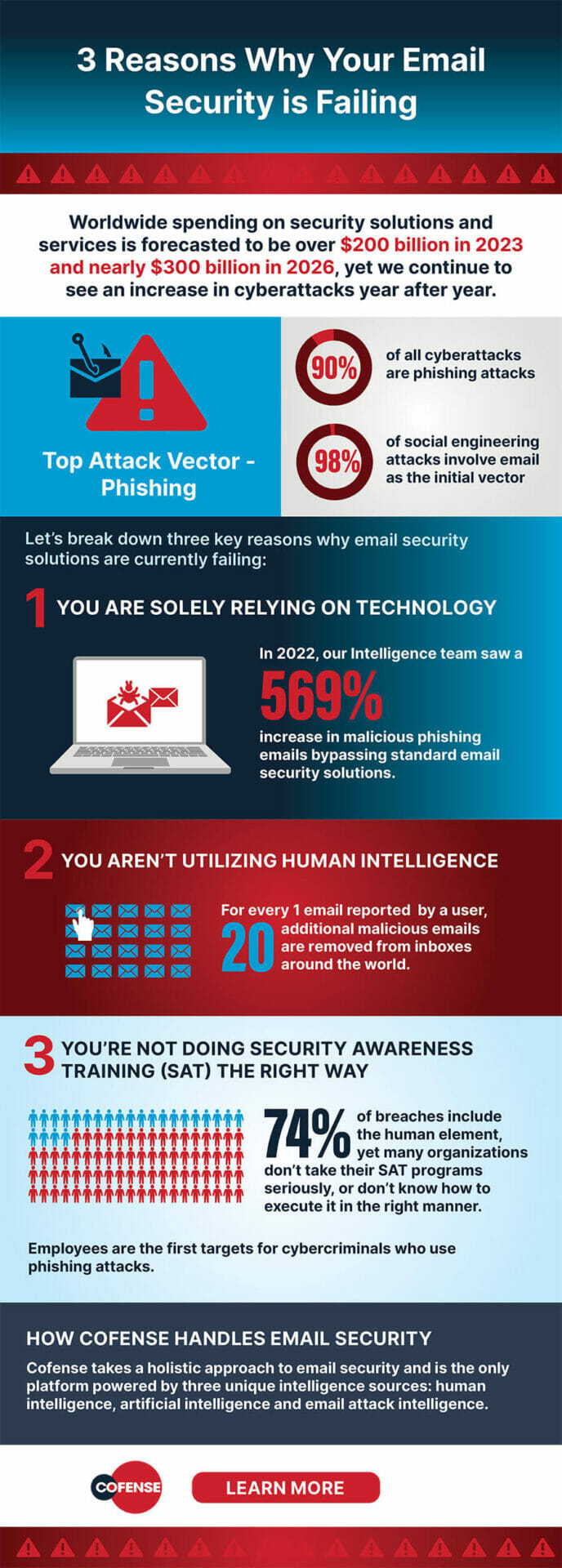Worldwide spending on security solutions and services is forecasted to be over $200 billion in 2023 and nearly $300 billion in 2026, yet we continue to see an increase in cyberattacks year after year. If organizations want to curb this trend, they should first focus on the top attack vector for threat actors, phishing. With phishing attacks making up more than 90% of all cyberattacks and the email threat vector making up 98% of social engineering attacks, it’s the logical place to start. Let’s break down three key reasons that many organizations email security solutions are currently failing them.
1. You are solely relying on technology
Despite the many advancements in artificial intelligence (AI) and cybersecurity technology, cyberattacks continue to occur and threaten businesses of all sizes. Many companies believe that implementing the latest cybersecurity technology is sufficient to protect their most critical assets. While technology can certainly help in preventing cyberattacks, it is not a foolproof solution. In fact, 50% of all email phishing attacks, including business email compromise (BEC) and credential theft, evade secure email gateways (SEGs). Yes, the advances in AI can become a powerful tool in email security, but it's still in its early stages and cybercriminals are constantly evolving their tactics to evade advanced technology. Remember, AI is only as powerful as the data and intelligence that is powering the system. Threat actors are also using AI to craft phishing emails to bypass your technology. In 2022, our Intelligence team saw a 569% increase in malicious phishing emails bypassing standard email security solutions. What does that tell us? Businesses need to go beyond just investing in technology and take a holistic approach to email security.
2. You aren’t utilizing Human Intelligence
Remember when we said that AI is only as powerful as the intelligence that powers it? If you’re not getting the latest IOCs and threats in real-time, how can you expect to stay ahead of the curve? You can’t. Human intelligence is vital to securing your email security solution as they are the first line of defense against advanced phishing threats. Yes, human intelligence needs to be combined with AI and Machine Learning (ML) technology, but sole reliance on those without the human element is a critical mistake. Taking it a step further, utilizing a global network of organizations and trained humans to detect, report and share threat information in real-time is the only way we will stay ahead of attacks. Companies need to invest in a cybersecurity solution that combines the power of technology with human intelligence.
3. You’re not doing Security Awareness Training (SAT) the right way
A staggering 74% of all breaches include the human element, yet many organizations don’t take their SAT programs seriously, or worse yet, they don’t know how to execute it in the right manner. If SAT isn’t taken seriously and old-school simulations are rolled out company-wide, most likely the employees won’t be invested in it either. However, it’s important to understand employees are the first targets for cybercriminals who use phishing attacks and that’s not changing anytime soon. Here are some things to consider.
- Educate, Don’t Trick
- Inform your employees of the importance of email security, and the role they play in protecting your organization from malicious actors. Your SAT program is meant to be educational and collaborative, not punitive and misleading.
- Your employees need to know how to identify phishing threats. To do this, you need to make sure you are utilizing real threats in your SAT programs. By utilizing real threats that are currently bypassing many standard email solutions, they will have a step up on the attackers.
- Build a Positive Culture of Reporting
- Employees shouldn’t feel stressed about reporting a potentially suspicious or malicious email. Build a positive environment for them to be a part of.
- According to our intelligence team, for every 1 email reported by a user, an average of 20 additional malicious emails are removed from inboxes around the world. They are a 20X MULTIPLIER.
- Acknowledge Them
- They should be treated as an asset, not a liability.
- Reward them for reporting suspicious emails. Make sure they know they are valued.
- Your SAT program is more than generic simulations
- While simulations are important, it’s a piece of a much larger SAT program that includes ongoing communication, training and more.
- Utilize the latest technology such as live action games and micro-learning modules to make your program more engaging.
How Cofense Handles Email Security
Cofense takes a holistic approach to email security and is the only platform powered by three unique intelligence sources: human intelligence, artificial intelligence and email attack intelligence. This email threat intelligence, along with our world-class SAT program, offers an end-to-end intelligent email security solution that is unsurpassed. Our human intelligence is the result of over 35 million educated and trained global users reporting suspected threats. Cofense Intelligence analyzes the reported emails and provides that intelligence into our product suite and directly to customers, allowing them to stay ahead of malicious attacks. Our solutions continuously evolve and learn with every new threat reported from our global network. That’s the power of our network effect. Our network of trained, human users provides an extra layer of protection to ensure threats are immediately identified and reported. Human involvement in the vetting process means that organizations can have confidence in their email security and can communicate that confidence to their customers. Cofense combines AI, machine learning, and human intelligence in our email security solutions to provide organizations with a comprehensive defense strategy that standard secure email gateways (SEGs) can’t compete with. To see what this looks like in action, contact us today to learn about our end-to-end intelligent email solutions and how they can help safeguard your organization.
Three Reasons Why Your Email Security is Failing Infographic
